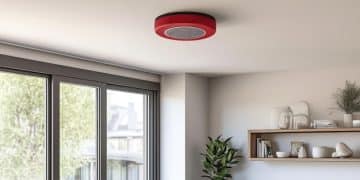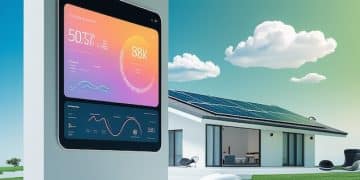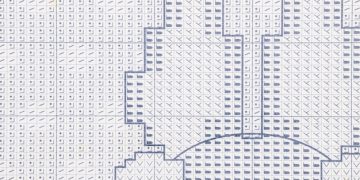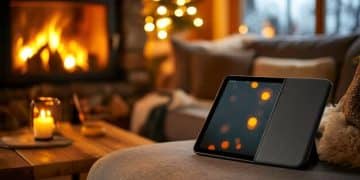Maximizing Energy Efficiency in New US Homes: 2025 Guide
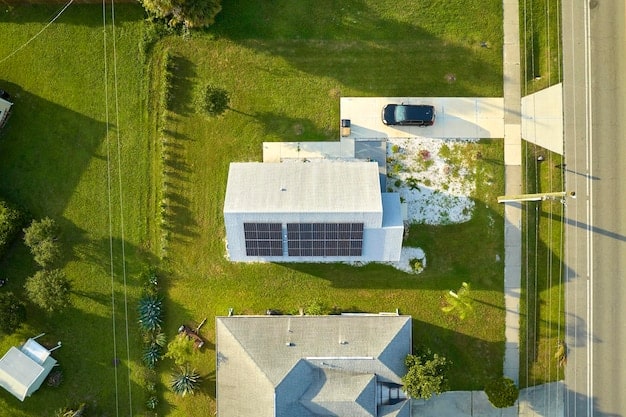
Anúncios
Achieving optimal energy efficiency in new US homes by 2025 requires a holistic approach, integrating advanced building materials, smart home technologies, and sustainable design principles to minimize environmental impact and maximize long-term cost savings for homeowners.
In an era increasingly defined by climate consciousness and economic pragmatism, the conversation around residential construction is shifting dramatically. The focus is no longer solely on aesthetics or basic functionality but profoundly on sustainability and efficiency. This guide to Maximizing Energy Efficiency in New US Homes: A 2025 Guide to Sustainable Construction delves into the innovative strategies and technologies poised to revolutionize how we build and inhabit homes across the United States. It offers a comprehensive look at the future of eco-friendly housing, emphasizing both financial benefits and environmental stewardship.
The Imperative for Energy-Efficient Housing in the US
The demand for energy-efficient homes in the United States is not merely a trend; it’s a critical response to escalating energy costs, growing environmental concerns, and evolving regulatory landscapes. Homeowners are increasingly seeking properties that offer reduced utility bills, enhanced comfort, and a smaller carbon footprint.
The construction industry is adapting by integrating advanced materials and innovative building practices. This shift is particularly evident as we approach 2025, a landmark year for new construction standards and consumer expectations. Builders are now focusing on holistic designs that consider every component from the ground up, promoting sustainability at every stage.
Driving Factors for Adoption
Several key factors are accelerating the adoption of energy-efficient construction. Economic incentives, such as tax credits and rebates, play a substantial role in making these homes more accessible. Furthermore, a rising tide of environmental awareness among consumers is pushing developers to prioritize green building options.
- Reduced Operating Costs: Lower utility bills are a primary motivator for homeowners.
- Enhanced Comfort: Better insulation and HVAC systems lead to more consistent indoor temperatures.
- Environmental Stewardship: Contributing to a reduced carbon footprint appeals to environmentally conscious buyers.
- Increased Resale Value: Energy-efficient homes often command higher prices in the real estate market.
The Role of Policy and Regulations
Government policies and building codes are becoming increasingly stringent, driving innovation in energy efficiency. States and municipalities are adopting more aggressive targets for emissions reduction and energy consumption, compelling builders to meet higher standards. These regulations often mandate specific levels of insulation, window performance, and HVAC system efficiency.
Compliance with these evolving standards is not just a legal requirement but also an opportunity for builders to differentiate their products. As these policies continue to tighten, the baseline for energy efficiency in new homes will invariably rise, making sustainable construction the norm rather than the exception.
The imperative for energy-efficient housing intertwines economic benefit with ecological responsibility. As we move towards 2025, the synergy between homeowner demand, technological innovation, and regulatory push will continue to shape a greener, more sustainable future for residential construction in the US.
Advanced Building Envelope Strategies for 2025
The building envelope—comprising the roof, walls, windows, doors, and foundation—is the primary barrier between a home’s interior and the external environment. Optimizing its performance is fundamental to achieving high levels of energy efficiency. By 2025, advancements in materials and construction techniques will allow for unprecedented levels of thermal performance and air tightness.
Focus on the envelope means minimizing heat transfer and air leakage, which are major culprits in energy waste. Innovations in insulation, window technology, and sealing methods are central to this objective, ensuring that heating and cooling systems operate with maximum efficiency.
Innovative Insulation Materials
Traditional insulation materials are being supplemented or replaced by more advanced options that offer superior thermal resistance with less bulk. Spray foam insulations, rigid foam boards, and even vacuum insulated panels are gaining traction. These materials provide higher R-values, which measure thermal resistance, and can effectively seal gaps and cracks that contribute to air leakage.
Another area of innovation includes insulated concrete forms (ICFs) for foundation and wall construction, which combine structural integrity with continuous insulation. Additionally, environmentally friendly options like recycled denim or cellulose insulation are being improved for performance and sustainability.
- Spray Foam Insulation: Offers excellent air sealing and high R-value.
- Rigid Foam Boards: Provides high thermal resistance in a compact form.
- Vacuum Insulated Panels (VIPs): Extremely high R-value for limited spaces.
- Insulated Concrete Forms (ICFs): Combines structural strength with superior insulation.
High-Performance Windows and Doors
Windows and doors are often a significant source of energy loss. By 2025, standard practice will involve multi-pane windows (double or triple-pane) with low-emissivity (Low-E) coatings. These coatings reduce heat transfer by reflecting infrared radiation, keeping heat inside during winter and outside during summer.
Frames made from fiberglass or vinyl offer better thermal breaks than traditional aluminum, further enhancing performance. Advanced sealing techniques, including continuous air barriers and robust weatherstripping, are crucial for minimizing drafts and ensuring the overall airtightness of the building envelope. These combined elements reduce the strain on HVAC systems and maintain constant indoor temperatures.

The advancements in building envelope technologies are pivotal in creating homes that are not only energy-efficient but also incredibly comfortable and resilient. By prioritizing these elements, new US homes will be better equipped to handle varying climates and provide long-term energy savings for their occupants.
Smart HVAC Systems and Renewable Energy Integration
Efficient heating, ventilation, and air conditioning (HVAC) systems are cornerstone components of an energy-efficient home. Combined with the strategic integration of renewable energy sources, they represent a powerful synergy for reducing reliance on fossil fuels and lowering utility costs. By 2025, these systems will be even smarter, more integrated, and more prevalent in new US homes.
The movement towards electrification of homes, particularly concerning heating and cooling, is gaining significant momentum. This trend aims to replace traditional fossil fuel-based systems with electric alternatives, often powered by renewable energy, reducing greenhouse gas emissions.
Advanced HVAC Technologies
Heat pump technology is at the forefront of efficient heating and cooling. Air-source heat pumps (ASHPs) and geothermal heat pumps (GSHPs) are significantly more efficient than conventional furnaces and air conditioners because they transfer heat rather than generate it. ASHPs are becoming more adept at operating efficiently in colder climates, broadening their applicability across the US.
Smart thermostats and zonal control systems further optimize HVAC performance. These intelligent systems learn homeowner preferences, adjust temperatures based on occupancy, and can be remotely controlled via smartphone apps, leading to precise temperature regulation and minimizing wasted energy.
- Air-Source Heat Pumps (ASHPs): Highly efficient for both heating and cooling across various climates.
- Geothermal Heat Pumps (GSHPs): Utilizes stable ground temperatures for exceptional efficiency.
- Variable Refrigerant Flow (VRF) Systems: Allows for simultaneous heating and cooling in different zones.
- Energy Recovery Ventilators (ERVs) / Heat Recovery Ventilators (HRVs): Improve indoor air quality while recovering energy from outgoing air.
Seamless Renewable Energy Integration
Solar photovoltaic (PV) systems are becoming a standard feature in many new constructions. Advances in panel efficiency, aesthetics, and energy storage solutions (such as home batteries) make solar power an increasingly attractive and viable option. Integrated solar roofing tiles are also offering a more discreet and aesthetically pleasing alternative to traditional panels.
Wind energy, while less common for individual homes, can be part of broader community-level energy strategies. Micro-hydro systems might be considered in specific geographic locations with access to running water. The key is to design homes that can either produce all or a significant portion of their own energy needs, moving towards net-zero or even net-positive energy consumption.
The future of energy-efficient homes in the US will heavily rely on these sophisticated HVAC systems working in tandem with increasingly accessible and efficient renewable energy sources. This integration marks a crucial step towards true energy independence and environmental sustainability for homeowners.
Water Conservation and Smart Appliances
Beyond heating and cooling, water consumption and appliance efficiency significantly impact a home’s overall environmental footprint and operating costs. By 2025, new homes in the US will increasingly incorporate advanced strategies for water conservation and feature smart, energy-saving appliances designed for minimal resource use.
The focus on water conservation acknowledges the growing pressures on freshwater resources in many regions. Integrating systems that reduce water waste not only benefits the environment but also lowers utility bills for homeowners, making these features highly desirable.
Innovative Water-Saving Technologies
Low-flow fixtures for showers, toilets, and faucets are becoming standard, significantly reducing water usage without compromising performance. Dual-flush toilets and water-efficient showerheads are now common and effective. Rainwater harvesting systems, which collect and store rainwater for irrigation or non-potable uses, are also gaining popularity.
Greywater recycling systems, which treat and reuse water from sinks, showers, and laundry for toilet flushing or gardening, represent a more advanced approach to water conservation. These systems can drastically cut down on a home’s potable water demand, especially in areas prone to drought.
- Low-Flow Plumbing Fixtures: Dramatically reduce water consumption for daily activities.
- Rainwater Harvesting: Collects and uses rainwater for non-potable applications.
- Greywater Recycling Systems: Reuses water from showers and sinks for irrigation or toilet flushing.
- Water-Smart Landscaping: Employs drought-tolerant plants and efficient irrigation methods like drip systems.
Energy-Efficient and Smart Appliances
The evolution of home appliances continues to push boundaries in terms of energy and water efficiency. Products bearing the ENERGY STAR label are rigorously tested to ensure they meet stringent efficiency guidelines. Refrigerators, dishwashers, and washing machines are designed to consume less electricity and water while delivering superior performance.
Beyond basic efficiency, smart appliances offer enhanced control and optimization. Connected to home networks, they can be programmed to run during off-peak energy hours, diagnose issues, or even order supplies. This connectivity allows for finer control over resource consumption, responding directly to homeowner habits and energy grid conditions.
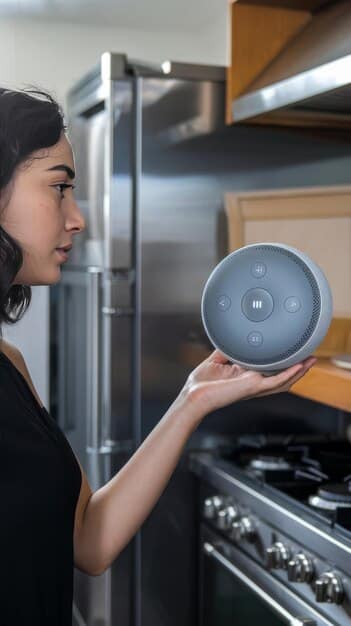
Integrating these dual strategies for water conservation and smart appliance use ensures that new homes in the US are not only energy-efficient in terms of heating and cooling but also holistically sustainable across all aspects of daily living. This approach provides significant savings and contributes to a more responsible interaction with natural resources.
Health, Comfort, and Indoor Air Quality
While energy efficiency often focuses on reducing resource consumption and costs, an equally vital aspect of modern sustainable construction is the emphasis on occupant health, comfort, and indoor air quality (IAQ). A truly efficient home provides a healthy and pleasant living environment, minimizing exposure to pollutants and maintaining optimal thermal conditions.
By 2025, new US homes will increasingly integrate features that prioritize human well-being, recognizing that a house is more than just an energy-efficient structure; it’s a sanctuary for its inhabitants. This means carefully selecting materials, optimizing ventilation, and managing indoor humidity levels.
Ensuring Superior Indoor Air Quality
Achieving excellent IAQ involves managing both the sources of indoor pollutants and providing adequate ventilation. Low-VOC (volatile organic compound) paints, adhesives, and flooring materials are becoming standard, reducing the emission of harmful chemicals into the indoor environment. Proper filtration systems within HVAC units, including HEPA filters, effectively capture dust, pollen, and other allergens.
Mechanical ventilation systems, such as Energy Recovery Ventilators (ERVs) and Heat Recovery Ventilators (HRVs), are crucial for supplying fresh outdoor air while minimizing energy loss. These systems ensure a continuous exchange of air, preventing the buildup of stale air and pollutants, a particular concern in tightly sealed, energy-efficient homes.
Thermal Comfort and Occupant Well-being
Thermal comfort is about more than just maintaining a set temperature; it involves factors like humidity, radiant heat, and air movement. Energy-efficient building envelopes, coupled with precise HVAC systems, contribute significantly to consistent indoor temperatures and reduced drafts. This balance prevents hot spots and cold spots, ensuring a uniform and comfortable environment throughout the home.
Beyond insulation and HVAC, aspects like natural daylighting, through well-placed windows and skylights, can reduce the need for artificial lighting and positively impact mood and productivity. Smart controls for lighting and window coverings allow occupants to tailor their environment to their preferences, enhancing both comfort and energy efficiency.
Ultimately, a strong focus on health, comfort, and indoor air quality elevates the value proposition of energy-efficient homes beyond mere cost savings. It transforms them into truly desirable living spaces that support the long-term well-being of their occupants, making sustainable construction a holistic endeavor for communities and individuals alike.
Financing Energy-Efficient Home Construction
The initial investment for building an energy-efficient home can sometimes be higher than that of a conventional home, primarily due to the cost of advanced materials, technologies, and specialized labor. However, numerous financing options and incentives are emerging to help bridge this gap, recognizing the long-term financial and environmental benefits.
By 2025, the financial landscape will be even more supportive of green building, with various programs designed to make sustainable construction accessible to a broader range of homeowners and developers. Understanding these options is key to unlocking the full potential of energy-efficient homes.
Green Mortgages and Loans
Green mortgages, also known as energy-efficient mortgages (EEMs), allow homebuyers to finance energy-saving improvements into their home loans. These mortgages typically consider the projected utility savings when determining a borrower’s qualification or loan amount, making it easier to afford a more efficient, albeit slightly more expensive, home.
FHA (Federal Housing Administration) and VA (Department of Veterans Affairs) loans also offer specific programs that encourage energy efficiency. Additionally, some private lenders and credit unions are developing their own “eco-friendly” loan products with favorable terms for sustainable construction and renovation.
- Energy-Efficient Mortgages (EEMs): Factor in potential utility savings for higher loan amounts.
- Federal Housing Administration (FHA) Energy Efficient Mortgage: Allows for financing of energy improvements.
- VA Loan Energy Efficient Mortgage: Offers similar benefits for eligible veterans.
- Private Bank Green Loans: Specialized loan products incentivizing sustainable building.
Government Incentives and Rebates
Various government bodies, from federal to local, offer incentives to encourage energy-efficient construction. Federal tax credits are often available for specific renewable energy installations, such as solar panels, or for meeting certain energy efficiency standards.
State and local governments, as well as utility companies, frequently provide rebates for purchasing energy-efficient appliances, installing heat pumps, or upgrading insulation. These programs can significantly offset the upfront costs, making sustainable features more attractive financially. It’s crucial for prospective builders and homeowners to research the specific incentives available in their region.
Understanding and leveraging these financing mechanisms is critical for “Maximizing Energy Efficiency in New US Homes: A 2025 Guide to Sustainable Construction.” These financial tools not only alleviate the initial investment burden but also highlight the growing recognition of energy-efficient homes as wise and sustainable investments for the future.
| Key Area | Brief Description |
|---|---|
| ☀️ Renewable Energy | Integration of solar panels and innovative energy storage solutions. |
| 🏡 Advanced Building Envelope | Superior insulation, high-performance windows, and airtight construction. |
| 💧 Water Efficiency | Low-flow fixtures and greywater recycling systems for reduced consumption. |
| 💰 Financing & Incentives | Access to green mortgages, tax credits, and rebates to support investment. |
Frequently Asked Questions about Energy Efficiency in New US Homes
The primary benefits include significantly reduced utility bills due to lower energy consumption for heating, cooling, and appliances. Additionally, these homes offer enhanced indoor comfort, a reduced environmental footprint, and often command higher resale values, providing long-term financial and ecological advantages for homeowners.
Building codes are continuously updated to mandate higher energy efficiency standards for new construction. These codes often specify minimum requirements for insulation levels, window performance coefficients, and HVAC system efficiencies. Compliance ensures new homes meet a baseline for energy conservation, pushing the industry towards more sustainable practices.
Smart home technologies enable optimized energy use through automation and remote control. Smart thermostats learn and adjust to occupancy patterns, while smart lighting systems enhance efficiency by turning off lights when not needed. These technologies provide homeowners with greater control and insight into their energy consumption, leading to significant savings.
Yes, numerous financial incentives exist. These include green mortgages (energy-efficient mortgages or EEMs) that factor in utility savings, federal tax credits for renewable energy installations like solar panels, and state or local rebates for efficient appliances or insulation upgrades. These programs help offset the initial investment costs associated with eco-friendly construction.
Energy-efficient homes are often tightly sealed, making proper ventilation crucial for indoor air quality. Systems like ERVs or HRVs bring in fresh air while recovering energy, preventing pollutant buildup from low-VOC materials. This ensures a healthy indoor environment by controlling humidity and minimizing allergens, contributing to overall occupant well-being.
Conclusion
The trajectory for new home construction in the US by 2025 is unequivocally headed towards greater energy efficiency and sustainability. From advanced building envelope designs that minimize heat loss to the seamless integration of renewable energy and smart home technologies, every aspect of residential building is undergoing a transformative shift. This evolution is driven by a powerful combination of economic incentives, environmental imperatives, and a growing consumer demand for comfortable, healthy, and cost-effective living spaces. While the initial investment in these advanced homes may sometimes be higher, the long-term benefits in terms of reduced operating costs, enhanced property value, and a minimized ecological footprint make them a wise and increasingly necessary choice for the future.
